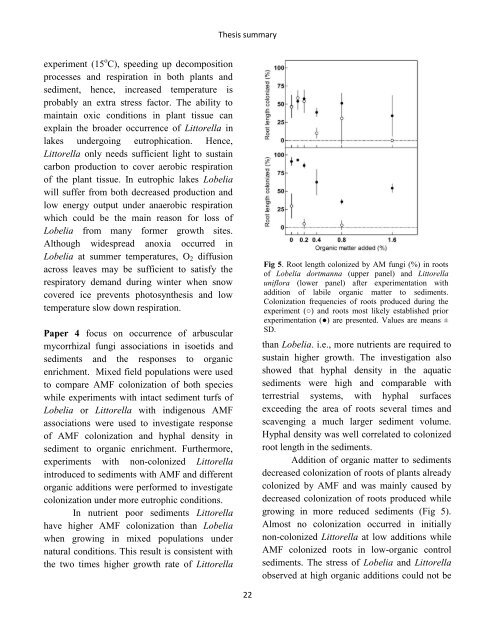Oxygen dynamics and plant-sediment interactions in isoetid ...
Oxygen dynamics and plant-sediment interactions in isoetid ...
Oxygen dynamics and plant-sediment interactions in isoetid ...
Create successful ePaper yourself
Turn your PDF publications into a flip-book with our unique Google optimized e-Paper software.
Thesis summaryexperiment (15 o C), speed<strong>in</strong>g up decompositionprocesses <strong>and</strong> respiration <strong>in</strong> both <strong>plant</strong>s <strong>and</strong><strong>sediment</strong>, hence, <strong>in</strong>creased temperature isprobably an extra stress factor. The ability toma<strong>in</strong>ta<strong>in</strong> oxic conditions <strong>in</strong> <strong>plant</strong> tissue canexpla<strong>in</strong> the broader occurrence of Littorella <strong>in</strong>lakes undergo<strong>in</strong>g eutrophication. Hence,Littorella only needs sufficient light to susta<strong>in</strong>carbon production to cover aerobic respirationof the <strong>plant</strong> tissue. In eutrophic lakes Lobeliawill suffer from both decreased production <strong>and</strong>low energy output under anaerobic respirationwhich could be the ma<strong>in</strong> reason for loss ofLobelia from many former growth sites.Although widespread anoxia occurred <strong>in</strong>Lobelia at summer temperatures, O 2 diffusionacross leaves may be sufficient to satisfy therespiratory dem<strong>and</strong> dur<strong>in</strong>g w<strong>in</strong>ter when snowcovered ice prevents photosynthesis <strong>and</strong> lowtemperature slow down respiration.Paper 4 focus on occurrence of arbuscularmycorrhizal fungi associations <strong>in</strong> <strong>isoetid</strong>s <strong>and</strong><strong>sediment</strong>s <strong>and</strong> the responses to organicenrichment. Mixed field populations were usedto compare AMF colonization of both specieswhile experiments with <strong>in</strong>tact <strong>sediment</strong> turfs ofLobelia or Littorella with <strong>in</strong>digenous AMFassociations were used to <strong>in</strong>vestigate responseof AMF colonization <strong>and</strong> hyphal density <strong>in</strong><strong>sediment</strong> to organic enrichment. Furthermore,experiments with non-colonized Littorella<strong>in</strong>troduced to <strong>sediment</strong>s with AMF <strong>and</strong> differentorganic additions were performed to <strong>in</strong>vestigatecolonization under more eutrophic conditions.In nutrient poor <strong>sediment</strong>s Littorellahave higher AMF colonization than Lobeliawhen grow<strong>in</strong>g <strong>in</strong> mixed populations undernatural conditions. This result is consistent withthe two times higher growth rate of LittorellaFig 5. Root length colonized by AM fungi (%) <strong>in</strong> rootsof Lobelia dortmanna (upper panel) <strong>and</strong> Littorellauniflora (lower panel) after experimentation withaddition of labile organic matter to <strong>sediment</strong>s.Colonization frequencies of roots produced dur<strong>in</strong>g theexperiment (○) <strong>and</strong> roots most likely established priorexperimentation (●) are presented. Values are means ±SD.than Lobelia. i.e., more nutrients are required tosusta<strong>in</strong> higher growth. The <strong>in</strong>vestigation alsoshowed that hyphal density <strong>in</strong> the aquatic<strong>sediment</strong>s were high <strong>and</strong> comparable withterrestrial systems, with hyphal surfacesexceed<strong>in</strong>g the area of roots several times <strong>and</strong>scaveng<strong>in</strong>g a much larger <strong>sediment</strong> volume.Hyphal density was well correlated to colonizedroot length <strong>in</strong> the <strong>sediment</strong>s.Addition of organic matter to <strong>sediment</strong>sdecreased colonization of roots of <strong>plant</strong>s alreadycolonized by AMF <strong>and</strong> was ma<strong>in</strong>ly caused bydecreased colonization of roots produced whilegrow<strong>in</strong>g <strong>in</strong> more reduced <strong>sediment</strong>s (Fig 5).Almost no colonization occurred <strong>in</strong> <strong>in</strong>itiallynon-colonized Littorella at low additions whileAMF colonized roots <strong>in</strong> low-organic control<strong>sediment</strong>s. The stress of Lobelia <strong>and</strong> Littorellaobserved at high organic additions could not be22
















